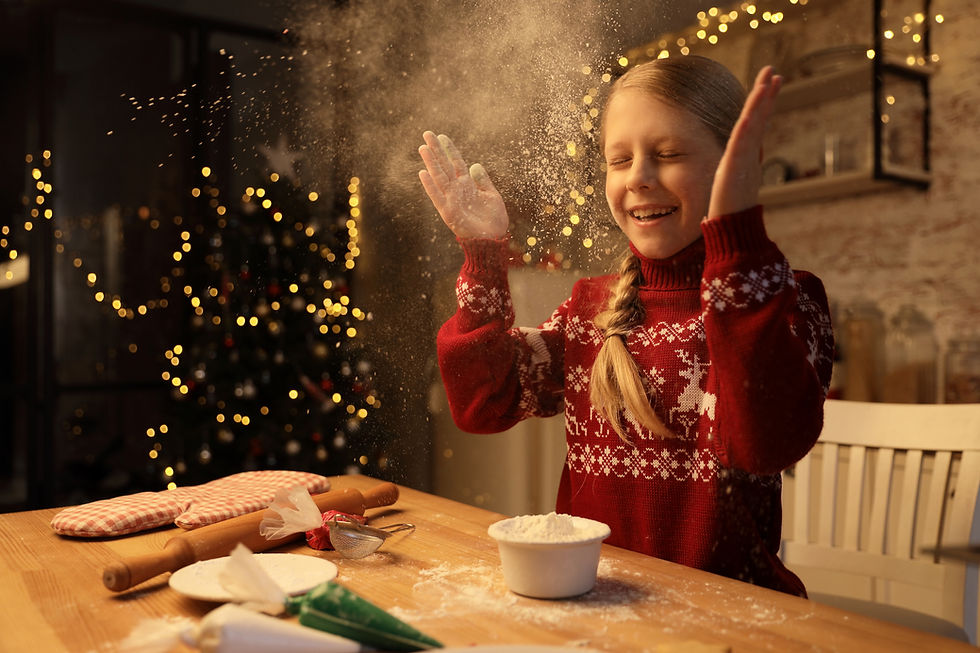Cooking Up Traditions: Recipes with Family Meaning
- Daisy Stevens
- Sep 30
- 4 min read
Do you ever find yourself wishing for more meaningful moments with your family? In our busy lives, it's easy to let connection slip through the cracks. But what if I told you that the simple act of cooking together could be a powerful way to create lasting family traditions? Recipes passed down through generations aren't just about the food; they're about the stories, the laughter, and the love shared around the table. Let's explore how to transform your kitchen into a hub for creating cherished family memories, one delicious recipe at a time.

The Heart of Family Traditions: Why Recipes Matter
More Than Just Food
Family recipes are more than just ingredients and instructions. They are vessels of history, culture, and love, passed down from one generation to the next.
Benefits of Cooking Up Traditions
Strengthens Family Bonds: Creates a sense of connection and belonging through shared experiences.
Preserves Family History: Keeps family stories and traditions alive.
Teaches Valuable Skills: Provides children with practical cooking skills and knowledge.
Encourages Healthy Eating: Fosters a positive relationship with food and promotes healthy eating habits.
Creates Lasting Memories: Creates cherished memories that will be treasured for years to come.
Offers a Sense of Predictability and Comfort: Provides routines that kids can rely on.
Creating Your Own Culinary Traditions
1. Start with What You Know
Reflect on Your Childhood: What are some of your favorite food memories from your childhood?
Ask Family Members: Talk to your parents, grandparents, and other relatives about their favorite recipes.
Gather Existing Recipes: Collect any handwritten recipes, cookbooks, or online resources that contain family favorites.
2. Involve the Kids
Let Them Choose: Let your children help choose which recipes to make.
Assign Age-Appropriate Tasks: Give them age-appropriate tasks in the kitchen, such as washing vegetables, measuring ingredients, or stirring sauces.
Make it Fun: Put on some music, tell jokes, and create a positive and supportive atmosphere in the kitchen.

3. Tell the Stories Behind the Recipes
Share the History: Share the stories behind the recipes, such as who created them, where they came from, or what special occasions they were served for.
Add Personal Anecdotes: Share your own personal anecdotes about the recipes and the memories they evoke.
Encourage Storytelling: Encourage your children to share their own stories and memories related to the recipes.
4. Document Your Culinary Adventures
Create a Family Cookbook: Create a physical or digital cookbook with your family's favorite recipes and stories.
Take Photos and Videos: Take photos and videos of your cooking sessions and the finished dishes.
Write Down Memories: Write down your memories and anecdotes related to the recipes.
5. Make it a Regular Event
Set a Schedule: Designate a specific day or time each week or month to cook together as a family.
Be Consistent: Stick to the schedule as much as possible to create a sense of tradition.
Be Flexible: Be willing to adjust the schedule as needed to accommodate changing circumstances.
Recipe Ideas with Family Meaning
Grandma's Famous Chocolate Chip Cookies
The Recipe: A classic chocolate chip cookie recipe passed down through generations.
The Story: Share the story of how your grandmother created the recipe and why it's so special to your family.
Dad's Secret-Ingredient Chili
The Recipe: A hearty chili recipe with a secret ingredient that makes it unique.
The Story: Share the story of how your dad perfected the recipe and why it's become a family favorite.
Mom's Comforting Chicken Noodle Soup
The Recipe: A soothing chicken noodle soup recipe that's perfect for sick days.
The Story: Share the story of how your mom always made this soup when you were feeling under the weather and how it always made you feel better.
Holiday Traditions: Gingerbread Houses
The Recipe: Use a classic gingerbread recipe (or a kit!) to build and decorate houses as a family each year.
The Story: Emphasize the creativity, collaboration, and friendly competition involved in decorating, and how each house reflects the family's personality.

Birthday Pancakes
The Recipe: Use your favorite pancake recipe (or a mix!) and add sprinkles, chocolate chips, or other fun toppings to make them special for birthdays.
The Story: Talk about how this tradition makes each birthday feel special and unique.
Real-Life Examples
The Smith family has a "pizza night" every Friday. They make homemade pizzas together, using a recipe that has been passed down through generations.
The Jones family bakes cookies together every Christmas. They use a recipe that was created by their great-grandmother.
Start Your Culinary Legacy
Cooking up traditions is a wonderful way to connect with your family, preserve your history, and create lasting memories. By starting with what you know, involving the kids, telling the stories behind the recipes, documenting your culinary adventures, and making it a regular event, you can transform your kitchen into a hub for creating cherished family traditions. So, gather your loved ones, grab your favorite recipes, and get ready to cook up some memories!
Want more simple and joyful ideas for your family? Join our newsletter and get free printables, activity ideas, and family tradition inspiration every week.










Comments